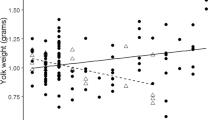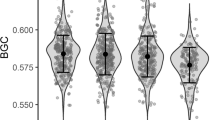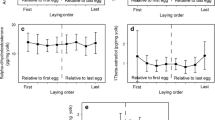Abstract
Maternal yolk androgens in bird eggs represent an important pathway along which offspring phenotype is shaped. Most of the hormone-mediated maternal effects are highly important in the context of sibling competition. However, there is also increasing evidence for long-lasting effects far beyond the nestling period, and these effects may have important consequences on the reproductive success of the offspring. Here, we investigated the effects of experimentally elevated yolk testosterone concentrations on growth and reproduction in female canaries. Elevated yolk testosterone concentrations enhanced the post-natal growth rate, but not the asymptotic mass, and reduced the survival probability. The latter may be a consequence of the higher growth rate, which may have rendered females hatching from testosterone-treated eggs (T-females) more vulnerable to harsh environmental conditions. Adult T-females made a larger investment in their clutch by laying more but not heavier eggs than females hatching from control-treated eggs. Our results suggest that the observed long-lasting effect on clutch size relates to changes in the growth trajectory rather than being a direct consequence of testosterone, since studies manipulating early growth conditions obtained similar results. Clearly, further studies are now required in order to investigate the intriguing relationship between yolk testosterone, elevated growth rates, and clutch size.



Similar content being viewed by others
References
Arendt JD (1997) Adaptive intrinsic growth rates: an integration across taxa. Q Rev Biol 72:149–177
Benowitz-Fredericks ZM, Kitaysky AS (2005) Benefits and costs of rapid growth in common murre chicks Uria aalge. J Avian Biol 36:287–294
Blount JD, Metcalfe NB, Arnold KE, Surai PF, Monaghan P (2006) Effects of neonatal nutrition on adult reproduction in a passerine bird. Ibis 148:509–514
Bryk AS, Raudenbush SW (1993) Hierarchical linear models: application and data analysis method. Sage, Newbury Park
Carere C, Balthazart J (2007) Sexual versus individual differentiation: the controversial role of avian maternal hormones. Trends Endocrinol Metab 18:73–80
Christians JK (2002) Avian egg size: variation within species and inflexibility within individuals. Biol Rev 77:1–26
Clotfelter ED, O’Neal DM, Gaudioso JM, Casto JM, Parker-Renga IM, Snajdr EA, Duffy DL, Nolan V Jr, Ketterson E (2004) Consequences of elevating plasma testosterone in females of a socially monogamous songbird: evidence of constraints on male evolution? Horm Behav 46:171–178
Eising CM, Eikenaar C, Schwabl H, Groothuis TGG (2001) Maternal androgens in black-headed gull (Larus ridibundus) eggs: consequences for chick development. Proc R Soc B 268:839–846
Eising CM, Müller W, Groothuis TGG (2006) Avian mothers produce different phenotypes by hormone deposition in their eggs. Biol Lett 2:20–22
Fitze PS, Clobert J, Richner H (2004) Long-term life-history consequences of ectoparasite-modulated growth and development. Ecology 85:2018–2026
Gil D (2003) Golden eggs: Maternal manipulation of offspring phenotype by egg androgen in birds. Ardeola 50:281–294
Gil D, Leboucher G, Lacroix A, Cue R, Kreutzer M (2004a) Female canaries produce eggs with greater amounts of testosterone when exposed to preferred male song. Horm Behav 45:64–70
Gil D, Heim C, Bulmer E, Rocha M, Puerta M, Naguib M (2004b) Negative effects of early developmental stress on yolk testosterone levels in a passerine bird. J Exp Biol 207:2215–2220
Goldstein H (1995) Multilevel statistical model, 2nd edn. Edward Arnold, London
Gorman HE, Nager R (2004) Prenatal conditions have long-term effects on offspring fecundity. Proc R Soc B 271:1923–1928
Griffiths R, Double MC, Orr K, Dawson RJG (1998) A DNA test to sex most birds. Mol Ecol 7:1071–1075
Groothuis TGG, Schwabl H (2008) Hormone-mediated maternal effect in birds: mechanisms matter but what do we know of them? Phil Trans R Soc B 363:1647–1661
Groothuis TGG, Müller W, von Engelhardt N, Carere C, Eising CM (2005a) Maternal hormones as a tool to adjust offspring phenotype in avian species. Neurosci Biobehav Rev 29:329–352
Groothuis TGG, Eising CM, Dijkstra C, Müller W (2005b) Balancing between costs and benefits of maternal hormone deposition in avian eggs. Biol Lett 1:78–81
Haywood S, Perrins CM (1992) Is clutch size in birds affected by environmental conditions during early growth? Proc R Soc B 249:195–197
Horak P (1994) Effect of nestling history on adult size and reproduction in the great tit. Ornis Fenn 71:47–54
Lipar JL, Ketterson ED (2000) Maternally derived yolk testosterone enhances the development of the hatching muscle in the red-winged blackbird Agelaius phoenicus. Proc R Soc B 267:2005–2010
Marshall RC, Leisler B, Catchpole CK, Schwabl H (2005) Male song quality affects circulating but not yolk steroid concentrations in female canaries (Serinus canaria). J Exp Biol 208:4593–4598
Metcalfe NB, Monaghan P (2001) Compensation for a bad start: Grow now pay later? Trends Ecol Evol 16:254–260
Müller W, Groothuis TGG, Dijkstra C, Kasprzik A, Alatalo RV, Siitari H (2005a) Prenatal androgen exposure modulates cellular and humoral immune function of black-headed gull chicks. Proc R Soc B 272:1971–1977
Müller W, Groothuis TGG, Eising CM, Dijkstra C (2005b) An experimental study on the causes of sex-biased mortality in the black-headed gull—the possible role of testosterone. J Anim Ecol 74:735–741
Müller W, Vergauwen J, Eens M (2008) Yolk testosterone, postnatal growth and song in male canaries. Horm Behav 54:125–133
Navara KJ, Hill GE, Mendonca MT (2005) Variable effects of yolk androgens on growth, survival and immunity in Eastern bluebird nestlings. Physiol Biochem Zool 78:570–578
Potti J (1999) Maternal effects and the pervasive impact of nestling history on egg size in a passerine bird. Evolution 53:279–285
Partecke J, Schwabl H (2008) Organizational effects of maternal testosterone on reproductive behavior of adult house sparrows. Dev Neurobiol 68:1538–1548
Proctor H, Owens I (2000) Mites and birds: diversity, parasitism and evolution. Trends Ecol Evol 15:358–364
Ricklefs RE (1968) Patterns of growth in birds. Ibis 110:419–451
Ricklefs RE, Starck JM, Konarzewski M (1998) Internal constraints on growth in birds. In: Ricklefs RE, Starck JM (eds) Avian growth and development. Oxford University Press, New York, pp 266–287
Rubolini D, Romano M, Martinelli R, Leoni B, Saino N (2006) Effects of prenatal yolk androgens on armaments and ornaments of the ring-necked pheasant. Behav Ecol Sociobiol 59:549–560
Rubolini D, Martinelli R, von Engelhardt N, Romano M, Groothuis TGG, Fasola M, Saino N (2007) Consequences of prenatal androgen exposure for the reproductive performance of female pheasants (Phasianus colchicus). Proc R Soc B 274:137–142
Rutkowska J, Cichon M, Puerta M, Gil D (2005) Negative effects of elevated testosterone on female fecundity in zebra finches. Horm Behav 47:585–591
Rutkowska J, Wilk T, Cichon M (2007) Androgen-dependent maternal effects on offspring fitness in zebra finches. Behav Ecol Sociobiol 61:1211–1217
Saino N, Ferrari RP, Romano M, Martinelli R, Lacroix A, Gil D, Møller AP (2006) Maternal allocation of androgens and antagonistic effects of yolk androgens on sons and daughters. Behav Ecol 17:172–181
Schluter D, Gustafsson L (1993) Maternal inheritance of condition and clutch size in the collared flycatcher. Evolution 47:658–667
Schwabl H (1993) Yolk is a source of maternal testosterone for developing birds. Proc Natl Acad Sci USA 90:11446–11450
Schwabl H (1996) Maternal testosterone in the egg enhances postnatal growth. Comp Biochem Physiol 114:271–276
Searcy WA (1988) Do female red-winged blackbirds limit their own breeding densities? Ecology 69:85–95
Sockman KW, Weiss J, Webster MS, Schwabl H (2008) Sex-specific effects of yolk-androgens on growth of nestling American kestrels. Behav Ecol Sociobiol 62:671–625
Strasser R, Schwabl H (2004) Yolk testosterone organizes behavior and male plumage coloration in house sparrows (Passer domesticus). Behav Ecol Sociobiol 5:491–497
Tanvez A, Beguin N, Chastel O, Lacroix A, Leboucher G (2004) Sexually attractive phrases increase yolk androgens deposition in Canaries (Serinus canaria). Gen Comp Endocrinol 138:113–120
Tobler M, Sandell MI (2007) Yolk testosterone modulates persistence of neophobic responses in adult zebra finches, Taeniopygia guttata. Horm Behav 52:640–645
Tobler M, Granbom M, Sandell MI (2007) Maternal androgens in the pied fycatcher: timing of breeding and within-female consistency. Oecologia 151:731–740
Tschirren B, Saladin V, Fitze PS, Schwabl H, Richner H (2005) Maternal yolk testosterone does not modulate parasite susceptibility or immune function in great tit nestlings. J Anim Ecol 74:675–682
Tschirren B, Fitze PS, Richner H (2007) Maternal modulation of natal dispersal in a passerine bird: an adaptive strategy to cope with parasitism? Am Nat 169:87–93
Uller T, Eklöf J, Andersson S (2005) Female egg investment in relation to male sexual traits and the potential for transgenerational effects in sexual selection. Behav Ecol Sociobiol 57:584–590
Veiga JP, Polo V (2008) Fitness consequences of increased tesosterone levels in female spotless starlings. Am Nat 172:42–53
Veiga JP, Viñuela J, Cordero PJ, Aparicio JM, Polo V (2004) Experimentally increased testosterone affects social rank and primary sex ratio in the spotless starling. Horm Behav 46:47–53
von Engelhardt N, Groothuis TGG, Daan S, Dijkstra C (2004) Long-term effects of elevated yolk testosterone on offspring attractiveness and reproductive performance in the zebra finch, Taeniopygia guttata. In: Proximate control of avian sex allocation. A study on zebrafinches. PhD-thesis (2004): von Engelhardt, N., Rijksuniversiteit Groningen, Nederland, pp. 91–104
von Engelhardt N, Carere C, Dijkstra C, Groothuis TGG (2006) Sex-specific effects of yolk testosterone on survival, begging and growth of zebra finches. Proc R Soc B 273:65–70
Acknowledgments
We thank Peter Scheys and Geert Eens for their assistance with taking care of the animals. Comments by two anonymous referees helped to improve the manuscript. The experiment was performed under proper legislation by the Belgian law. This study was supported by a postdoctoral grant (1.5.033.07 to WM) and a research project (G.0130.07 to ME) from FWO Flanders Belgium.
Author information
Authors and Affiliations
Corresponding author
Additional information
Communicated by J. Graves
Rights and permissions
About this article
Cite this article
Müller, W., Vergauwen, J. & Eens, M. Long-lasting consequences of elevated yolk testosterone levels on female reproduction. Behav Ecol Sociobiol 63, 809–816 (2009). https://doi.org/10.1007/s00265-009-0714-9
Received:
Revised:
Accepted:
Published:
Issue Date:
DOI: https://doi.org/10.1007/s00265-009-0714-9




